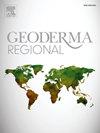以100米空间分辨率绘制埃塞俄比亚中部土壤肥力特性
IF 3.3
2区 农林科学
Q2 SOIL SCIENCE
引用次数: 0
摘要
准确的土壤属性图对有效的土壤养分管理至关重要。在埃塞俄比亚,化肥施用往往忽略了土壤性质的空间变异性,导致效率低下。该研究采用数字土壤制图技术,在埃塞俄比亚中部以100米分辨率生成五种关键土壤肥力特性的三维(3D)地图——总氮(TotalN)、可提取磷(OlsenP)、可交换钾(ExchK)、pH- h2o (pH)和有机碳(OC)。目标是(1)在评估预测不确定性的同时,在六个深度区间绘制地图;(2)评估表土数据与土壤剖面数据的模型训练整合;(3)将这些地图与Africa-SoilGrids、SoilGrids和iSDAsoil地图进行比较。我们使用了两个数据集:土壤剖面(1,379个剖面,4,179层)和表土(13,724个位置),并使用传递函数进行协调。分位数回归森林用于生成具有90%预测间隔的地图。模型使用80%的数据集和194个协变量(包括深度)进行校准,并使用剩余的20%进行评估。与仅使用土壤剖面数据相比,将表层土壤数据与土壤剖面数据相结合提高了表层土壤(0-20 cm) 5种土壤肥力特性的预测精度,显示出接近零的偏差,减少了均方根误差,并具有更高的模型效率系数(MEC)。它还增强了表土中pH、OlsenP、TotalN和ExchK的不确定度量化。然而,这些好处随着深度的增加而减少,在底土(20-50厘米)有轻微的改善,但在更深的土层(50-200厘米)没有,pH和OC的预测甚至略有偏差。在组合数据集模型中,pH的性能最高(MEC = 0.80), OlsenP的性能最低(MEC = 0.13)。从组合数据集模型生成的地图显示,与SoilGrids、Africa-SoilGrids和iSDAsoil相比,MEC提高了27%至超过1000%。此外,预测区间也是预测不确定性的真实表示,预测区间覆盖概率(PICP)值接近其理想值。这明显优于具有不切实际的低PICP值的SoilGrids和iSDAsoil。我们的结论是,本研究的100米分辨率3D地图提供了令人满意的准确性和现实的不确定性量化,使其成为目前在埃塞俄比亚中部制定特定地点肥料建议的最佳可用资源。本文章由计算机程序翻译,如有差异,请以英文原文为准。
Mapping soil fertility properties in central Ethiopia at 100 m spatial resolution
Accurate soil property maps are essential for effective soil nutrient management. In Ethiopia, fertilizer applications often ignored spatial variability in soil properties, leading to inefficiencies. This study employed digital soil mapping to generate three-dimensional (3D) maps of five key soil fertility properties—total nitrogen (TotalN), extractable phosphorus (OlsenP), exchangeable potassium (ExchK), pH-H2O (pH), and organic carbon (OC)—at 100 m resolution across central Ethiopia. The objectives were to (1) develop maps at six depth intervals while assessing prediction uncertainty; (2) evaluate the integration of topsoil data with soil profile data for model training; and (3) compare the maps with Africa-SoilGrids, SoilGrids, and iSDAsoil maps. We used two datasets: soil profile (1,379 profiles with 4,179 layers) and topsoil (13,724 locations), harmonized with transfer functions. Quantile regression forest was used to generate maps with 90 % prediction intervals. Models were calibrated with 80 % of the dataset and 194 covariates, including depth, and evaluated with the remaining 20 %. Integrating topsoil data with the soil profile dataset improved prediction accuracy for the five soil fertility properties in the topsoil (0–20 cm), demonstrating near-zero bias, reduced root mean squared error, and a higher model efficiency coefficient (MEC), compared to only using the soil profile dataset. It also enhanced uncertainty quantification for pH, OlsenP, TotalN, and ExchK in the topsoil. However, these benefits diminished with depth, with slight improvements in the subsoil (20–50 cm) but none in the deeper layers (50–200 cm) where pH and OC predictions were even slightly biased. Among the combined dataset models, the highest performance was for pH (MEC = 0.80), while the lowest was for OlsenP (MEC = 0.13). The maps generated from the combined dataset models showed MEC improvements of 27 % to over 1,000 % compared to SoilGrids, Africa-SoilGrids, and iSDAsoil. Additionally, the prediction intervals were also a realistic representation of the prediction uncertainty, with prediction interval coverage probability (PICP) values close to their ideal value. This markedly outperformed SoilGrids and iSDAsoil, which had unrealistically low PICP values. We conclude that the 100 m resolution 3D maps from this study offer satisfactory accuracy and realistic uncertainty quantification, making them the currently best available resource for developing location-specific fertilizer recommendations in central Ethiopia.
求助全文
通过发布文献求助,成功后即可免费获取论文全文。
去求助
来源期刊

Geoderma Regional
Agricultural and Biological Sciences-Soil Science
CiteScore
6.10
自引率
7.30%
发文量
122
审稿时长
76 days
期刊介绍:
Global issues require studies and solutions on national and regional levels. Geoderma Regional focuses on studies that increase understanding and advance our scientific knowledge of soils in all regions of the world. The journal embraces every aspect of soil science and welcomes reviews of regional progress.
 求助内容:
求助内容: 应助结果提醒方式:
应助结果提醒方式:


